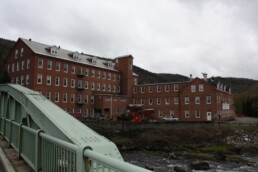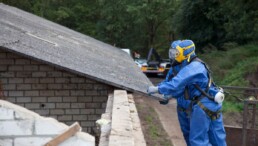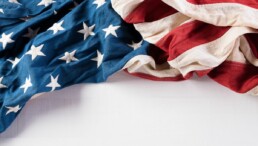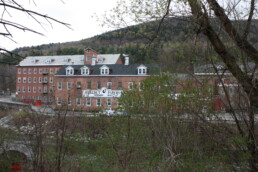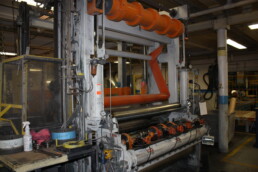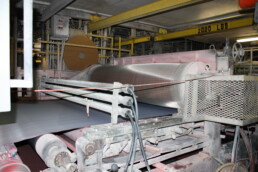“A Berkshire Insurance Bet Went Bad. It Wants a Bankruptcy Court to Limit the Damage.” – Michael Shepard Quoted in Article
Michael Shepard’s insights were featured in The New York Times article, “A Berkshire Insurance Bet Went Bad. It Wants a Bankruptcy Court to Limit the Damage.”
“They’re not bankrupting it because the company all of a sudden couldn’t pay its bills,” said Michael Shepard, a lawyer representing asbestos-injury claimants. “They’re bankrupting it because all of a sudden it doesn’t look like a good investment anymore.”
How Can a Victim Advocate Help You?
Experiencing a violent crime—especially sexual abuse or assault—can leave deep emotional and psychological wounds. Survivors often face a complex and overwhelming path to healing and justice, going through a range of difficult emotions on their road to recovery. You don’t have to navigate that path alone. A victim’s advocate is someone who walks beside you, offering support, guidance, and compassion every step of the way.
Victim advocates are trained professionals who provide a safe, nonjudgmental space where you can begin to process what’s happened. They’re here to listen, to help you understand your rights, and to make sure you feel empowered and informed as you move forward—at your own pace.
A Voice For Victims
In the aftermath of a traumatic experience, many survivors feel overwhelmed by fear, uncertainty, or the belief that no one will truly understand or believe what they’ve been through. A victim advocate stands alongside you, not to speak for you, but to help you feel strong enough to speak for yourself.
Advocates understand how difficult it can be to relive painful events, especially in intimidating environments like police interviews, legal proceedings, or courtroom hearings. They help you organize your thoughts, remember key details, and feel prepared for whatever step comes next. If you’re unsure about whether to take legal action, your advocate can offer clarity so you can make choices that feel right for you.
Most importantly, they remind you that you are not alone. Your voice deserves to be heard, and your experience deserves to be acknowledged with empathy, respect, and dignity.
A Caring Ally
A victim advocate can help you understand your legal rights and explain your options in clear, simple terms. They can guide you through each stage of the justice system, from reporting a crime, to navigating complex procedures, and even attending hearings and other important meetings with you, all while keeping your well-being front and center.
They’re also there to help you prepare important paperwork, such as restraining orders, and to connect you with local resources like counseling services, support groups, or other information. Your advocate will ensure that your voice is heard, your needs are respected, and your choices are honored.
Our In-House Victim Advocate
At Shepard O’Donnell, we know how difficult it can be to come forward with a sexual abuse claim. That’s why our legal team includes a dedicated in-house victim advocate. From your first conversation with us, you’ll have someone by your side who understands the emotional toll of trauma and is there to offer guidance, comfort, and practical support.
If you have been the victim of physician sexual abuse, school sexual abuse, or sexual abuse while attending a Residential Treatment Facility, we encourage you to take the important first step in holding your abuser accountable. Contact us at (800) 451-4471 for a free, confidential, no-obligation discussion about possible legal action. We would be glad to explain what’s involved in the process of filing a claim. Read more about our approach to working with sexual abuse survivors in our blog.
We are committed to protecting your confidentiality and ensuring that you feel safe and supported throughout the legal process. Your healing, your rights, and your story are important, not just as a legal case, but as a person who matters.
Sexual Abuse Common in Private Youth Residential Treatment Facilities
If you suffered sexual abuse at a residential treatment facility (RTF), you are not alone. RTFs are intended to support vulnerable young populations suffering from mental health, substance use, and behavioral challenges. Troubled children and youth enter these facilities expecting help and support yet the very people tasked with helping them are sometimes the ones who cause further trauma.
In 2024, the Senate Finance Committee released a scathing report revealing widespread abuse and neglect at many youth RTFs across the country. Based on a two-year investigation into dozens of facilities, including those in Massachusetts, operated by four of the largest behavioral health providers in the country—Universal Health Services, Acadia Healthcare, Devereux Advanced Behavioral Health, and Vivant Behavioral Healthcare—the report reveals that RTF providers frequently optimize profit over the wellbeing and safety of children and youth. While this report concerns placements financed by Medicaid and the child welfare system, children whose stays are covered by private and public funds often overlap in the same programs, including in facilities at-issue in this investigation.
A key finding of the investigation is that children “suffer harms such as the risk of physical, sexual, and emotional abuse at the hands of staff and peers, improperly executed and overused restraint and seclusion, inadequate treatment and supervision, and non-homelike environments that are often unsanitary and unsafe. These harms amount to acute safety concerns and have long-term effects, including suffering, trauma and even death.”
Prioritizing Profits Over Patients
How can this happen? Private residential treatment is big business. Facilities are marketed as nurturing, supportive solutions to challenging behavioral and mental health challenges. Websites are full of encouraging language such as “treating individuals with respect”, “operating with integrity”, “dedication of staff”, “provid[ing] a quality, effective and positive experience”, “patients are our top priority”, and “compassionate, understanding behavioral health support”.
It turns out much of this language is lip service, intended to keep shareholders happy, federal dollars flowing, and trusting, well-meaning parents in the dark so they keep sending their children for what they believe will be “compassionate, quality care.”
Because many RTFs are reimbursed by the government on a per patient basis, they are incentivized to cut costs and corners in order to reap big profits. The congressional report calls this out directly: “The risk of harm to children in RTFs is endemic to the operating model. The harms children in RTFs experienced are the direct, causal result of an operating model that incentivizes providers to optimize revenues and operating and profit margin.”
Unqualified, Overburdened, Undertrained Staff
Part of their cost-cutting measures involves those related to staffing. Whether that means hiring less qualified (and, therefore, cheaper) staff or not enough staff in relation to the number of patients, the resulting lack of appropriate personnel and supervision creates an environment ripe for abuse.
The congressional investigation found that “children spend the majority of their time supervised by…staff who are ill-equipped to address their complex behavioral health needs and, in some cases, children interact with staff who pose a direct threat to their wellbeing… In the worst of circumstances, children at RTFs suffer…sexual, physical, verbal, or emotional abuse at the hands of staff. Mistreatment is endemic to the conditions at RTFs.”
Whether it is the staff perpetrating these atrocities or creating an environment in which they are allowed to occur, unchecked, by others, the lack of investment in qualified employees is putting patients in danger. Maximizing profits at the expense of the most vulnerable patients is abhorrent and must be stopped.
Blaming the Victim – Again
It is an unfortunate reality that predators target the most vulnerable. It stands to reason, then, that RTFs should have a heightened duty of care, with more than the average protections in place to shield their vulnerable, often fragile patients. The congressional investigation found that, in reality, “horrific instances of sexual abuse persist unremediated inside RTFs.”
Many of these facilities have inadequate processes or policies in place to protect their patients or give them a voice. Sadly, because of their mental health or behavioral challenges, patients are frequently discounted as people, and their complaints against staff members or fellow patients go unheeded. In some instances, even multiple complaints about individuals or situations have not been followed up on, and accused staff are simply moved to another wing or another facility altogether without disciplinary action.
Scapegoating tactics abound. Accused staff members or peers will claim that sexual activity was consensual, that the victim was “promiscuous”, that they were “in a relationship”, or a host of other excuses that deflect blame away from themselves. And, facilities hide behind HIPAA as an excuse to keep these incidents quiet. Victims feel victimized all over again when their complaints are minimized or not taken seriously.
Denial: We’ve Seen This Playbook Before
Any attempts at remedial action fail to address the underlying culture of harm at RTFs. Despite being found in violation of state and federal regulations, RTFs in Massachusetts rely on the state’s lack of resources for follow-up to ignore demands to improve practices. This is very much the kind of playbook that we, at Shepard O’Donnell, have seen before from tobacco and asbestos companies: there is a well-known, well-documented, dangerous, and systemic problem, but the companies continue to profit and, therefore, use their substantial resources to fight in the courts and in the press to deny any wrongdoing.
And yet, despite their denials, asbestos manufacturers and tobacco companies regularly pay large financial settlements to victims. Isn’t it time RTFs were held to the same account?
Contact a Sexual Abuse Attorney
If you suffered sexual abuse at a RTF, know that it was not your fault. As this congressional report shows, abuse is rampant in many of these facilities. The companies that own and manage these facilities have allowed, even enabled, this abuse to take place and should be held financially accountable.
In our experience working with survivors of sexual abuse, we have learned how difficult it is, not only to come to terms with what happened to you, but also how difficult it is to come forward and tell your story. We are empathetic yet fierce defenders of your honor and promise to do everything in our power to hold sexual offenders and the institutions that employ them, accountable for the harm they’ve inflicted. When you’re ready, we are available for a confidential, no-obligation discussion about possible legal action.
Were You Exposed to Asbestos at the Willow Mill in South Lee, MA?
One of the most common ways people are exposed to asbestos is in the workplace. Pipefitters, boilermakers, construction workers, auto mechanics, even veterans were regularly exposed to asbestos on the job, inhaling the microscopic fibers disturbed during the course of their work and increasing their risk of developing mesothelioma later in life. Based on our decades of work on behalf of mesothelioma victims and their families, we know that one of the deadliest sources of workplace asbestos exposure was in paper mills.
From the wet end to the dry end of the paper making process, the Willow Mill in South Lee, Massachusetts used asbestos extensively in its paper-making for several decades. Originating as the Hurlbut Mill on the banks of the Housatonic River in South Lee in the mid-1800s, the mill was acquired by Mead Corporation in the 1950s and soon after began making specialty papers. After merging with the Westvaco Corporation in the early 2000s, MeadWestvaco continued operating the mill until it was sold to Onyx Paper, which operates it to this day.
Among other types of paper, the Willow Mill produced the 650-series specialty friction paper based on a design patent co-owned by Mead and BorgWarner, an automotive supplier, to be used in automatic transmissions in cars and trucks. This paper contained asbestos, which is both durable and heat resistant, making it ideal for use in transmissions and clutch plates where significant heat is generated due to friction and was produced in South Lee until 1983. Evidence shows that the Mead Corporation recognized a problem with the way it was handling asbestos fibers at the Willow Mill.
The Deadly Life Cycle of Asbestos Friction Paper
The 650-series friction paper produced at the Willow Mill used two of the most dangerous forms of asbestos in the world: 1) crocidolite, also known as African Blue, the most carcinogenic type of asbestos, and 2) chrysotile, a less potent but still extremely dangerous fiber. Our extensive volume of evidence regarding asbestos use at the Willow Mill shows that, from the moment the asbestos shipment was picked up to the moment the final rolls of paper left the mill for the BorgWarner facility in Illinois, there were significant risks of exposure to deadly airborne asbestos fibers to workers and bystanders.
Before the asbestos even entered the facility, a driver was sent from the mill to Boston to meet the container ships arriving from South Africa to pick up a container of bags of raw asbestos for transport to Willow Mill. Once back at the mill in South Lee, the driver would unload the bags of African Blue, and employees would dump the 50lb bags of asbestos by hand into the hydropulper, releasing trillions of tiny airborne fibers. We know from internal documents that the company did not require workers to wear protective clothing or masks. Broken and open bags were often left in storage, further contaminating the air at the mill. Interestingly, we know of one driver who kept a chart showing pictures of venomous African snakes next to the loading platform. Oftentimes, the container from South Africa would have one or more stowaways hidden inside—colorful snakes that could slither out at any moment! Little did he know that the snakes were a far less deadly threat than the crocidolite itself.
The slurry created by the hydropulper was then spread onto screens to make the paper, was then pressed and dried, and rolled onto giant rolls by a rewinder. Each step of the process presented a hazard. Not only did the paper drying process itself produce asbestos dust, dryer felts often contained asbestos and the process of cutting or changing the felts also released respirable asbestos fibers. Rewinder operators were exposed to asbestos fibers as the dried paper was rolled. Cutter operators, whose job it was to smooth out the jagged edges of the rolled paper, were also exposed when asbestos-containing dust was created during the cutting process. The leftover scraps, or “broke”, were collected in the broke room, resulting in heavy exposure for those emptying and baling the scraps and shavings.
Mill workers regularly exposed during runs of asbestos grade paper include:
- rewinder operators and helpers
- brokemen
- slusher operators and helpers
- beater engineers, operators, and beaterman helpers and hands
- machine tenders, backtenders, hands and trainees
- cutter machine operators and helpers
- sorters
- trimmer operators
- technicians
- burning oven operators
- tour operators
- utility men
Dust hygiene reports from the Willow Mill reveal that exposure was greatest when bulk asbestos or paper was being handled. Areas where significant amounts of asbestos fibers were detected include: around the vent exhaust from the beater and slusher (into the basement), the test lab, between the wind-up reel and rewind, the slusher area, beater room, baler room, broke room, pulp storage area, dry end, and scales, as well as the shipping area.
The Occupational Safety and Health Administration issued its first emergency standard for asbestos in 1971 in an attempt to limit worker exposure. Despite the widespread knowledge and accepted understanding of the dangers of asbestos, MeadWestvaco’s Willow Mill continued to use raw asbestos fiber in the friction paper it was manufacturing in concert with Borg-Warner into the early 1980s.
Beyond the Willow Mill
It wasn’t just mill workers who were exposed. Unfortunately, the effects of asbestos exposure at the Willow Mill are far reaching.
Family Members of Willow Mill Workers
It stands to reason that workers who came into contact with asbestos fibers at work would carry these fibers back home, in their cars and on their clothing. Our clients include the spouses of former Willow Mill workers, and their sons and daughters, who only now are beginning to show symptoms of mesothelioma. Wives who regularly laundered contaminated clothing, and children giving daddy a hug when he got home from work, unwittingly breathed asbestos fibers into their lungs.
Willow Mill Contractors
Whether during scheduled shutdowns or unexpected breakdowns, outside contractors called in to repair and maintain equipment were also exposed to airborne asbestos fibers. When equipment was offline for regularly scheduled maintenance, every minute counted and it was often an “all-hands-on-deck” situation to get the mill back online as quickly as possible. Multiple contractors—including those not typically associated with obvious asbestos exposure—were often on site while machinery was being cleaned, painted, or overhauled, suffering asbestos exposures as a result. As for repairs, outside machinists, boilermakers, pipefitters and others who were called upon to service equipment throughout the Willow Mill were potentially exposed to airborne asbestos fibers released during the paper making process. Not only that, the thousands of pumps and valves, gaskets, packing, insulation, and pipes present in mills of all types often contained asbestos, regularly exposing these workers in their day-to-day jobs.
South Lee Community Members
Contaminated sludge, pieces of broke, and other byproducts of the paper-making process were dumped, uncovered, on several acres of land on the mill property, not only creating an environmentally toxic Superfund site in the town of South Lee, but also exposing waste haulers and workers who were tasked with maintaining this dump.
Auto Mechanics Nationwide
Perhaps the most wide-ranging impact is on auto mechanics across the country who regularly handle asbestos-containing vehicle parts. Most automatic-transmission vehicles manufactured until the 1980s used friction paper in the transmissions, including the 650-series friction paper produced at Mead Westvaco’s Willow Mill for BorgWarner. Any time these transmissions are repaired, serviced, or overhauled, asbestos fibers are disturbed and released into the surrounding air. Many of these older vehicles are still on the road today, which means auto mechanics working on these vehicles are even now at risk of being exposed to asbestos.
Contact an Experienced Mesothelioma Attorney
If you believe you or a loved one has developed mesothelioma as a result of their job history, we encourage you to reach out to an experienced mesothelioma lawyer to see if you may be entitled to financial compensation. Shepard O’Donnell’s extensive experience with mesothelioma cases originating in paper mills across Massachusetts and New Hampshire, including the Willow Mill, has resulted in life-changing verdicts or settlements for those suffering from this terrible disease and their families. Our significant collection of evidence regarding asbestos exposure in mills operated by Mead Westvaco, Hollingsworth & Vose, Kimberly Clarke, and Brown Company, includes proprietary information not used by other firms. Contact us for a free, no obligation consultation.
Photos taken by Shepard O’Donnell during site visits while investigating asbestos exposure at the Willow Mill. Copyright: Shepard O’Donnell
Why Is It So Hard To Quit Smoking?
It’s often a recurring New Year’s resolution for smokers: “This year, I’m going to quit!” We all know the many health benefits of quitting, but it’s hard! And the reason for that is because your body has become physically addicted to nicotine, the chemical found in tobacco. No, you don’t have an “addictive personality.” You have been enticed into consuming a highly addictive substance.
Experts recognize tobacco addiction as a chronic brain disease. Tobacco companies have known for decades that they were luring people into a harmful addiction, yet continued to do so through aggressive advertising. Even more damning, cigarette companies intentionally manipulated cigarettes to make them more addictive and deliberately misled the public about the dangers of smoking. As one company executive admitted: “Nicotine is addictive. We are, then, in the business of selling nicotine, an addictive drug.”
In addition to the health warnings on cigarette packages that cover cancer risks, birth defects, and lung disease, the government now requires warnings about addiction, such as those below, to be placed wherever cigarettes are sold. It seems, however, that it’s a matter of too little, too late for many.

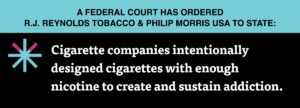

While nicotine itself does not cause cancer, it’s the drug that keeps us consuming products like cigarettes that contain cancer-causing ingredients including arsenic, formaldehyde, benzene, and lead. It is the devastating long-term effects of these chemicals on our health that we are trying to minimize when we quit smoking.
Nicotine Changes Your Brain
Cigarette addiction is not your fault. The nature of addiction involves the relentless pursuit of a drug or behavior that produces a positive reward despite negative consequences. When you take a drag of a cigarette and inhale the smoke, nicotine travels to your lungs and moves quickly to your brain, often within seconds of when it’s inhaled.
Once it hits your brain, nicotine activates several different neurotransmitters, including those responsible for reducing tension and anxiety, appetite suppression, and others whose effects are often perceived as positive. It also triggers the release of endorphins and dopamine, the so-called “feel-good” hormones—nature’s reward system.
Unfortunately, as dopamine levels begin to decline again, we feel the “need” for another cigarette, and the cycle starts again. To make matters worse, as our tolerance for nicotine builds up over time, we need more and more to bring us the level of pleasure we seek. The chemical effects of nicotine in our brains are what keeps us going back for more, which is why it’s so hard to quit.
Add to that the comfort some smokers take in the ritual of smoking, the place it can hold in a daily routine, the camaraderie found with fellow smokers, and there are many reasons why it can be difficult to stop. Research suggests that nicotine is as addictive as heroin, cocaine, or alcohol.
What Tools Can Help Me Quit?
The American Lung Association (ALA) says that it takes a smoker six to eleven attempts before they are completely smoke-free, so if at first you don’t succeed, don’t be discouraged. Whether you decide to go “cold turkey” or take a more measured approach, there are many different tools you can use to help including:
- self-help resources
- counseling
- nicotine replacement therapies (NRT)
- nicotine gum
- nicotine inhaler
- nicotine lozenge
- nicotine nasal spray
- nicotine patch
- prescriptions medications
- varenicline (Chantix®)
- bupropion SR (Zyban®)
- a combination of counseling and medication
Research by the National Institute for Health (NIH) suggests that a combination of counseling and medication is the most effective approach for quitting smoking, nearly tripling your chance of success. By contrast, the ALA says that only 4 to 7 percent of people who try to quit “cold turkey are successful in staying tobacco-free.” While it might seem counterintuitive, nicotine replacement therapy, or NRT, has been found to be helpful by gradually reducing the level of nicotine in your system thereby reducing your cravings for cigarettes and, by extension, the toxic chemicals found in cigarettes. Additionally, the prescription medications listed above have been approved by the FDA. They are considered safe and effective at helping people quit smoking by helping relieve some of the withdrawal symptoms. We encourage you to reach out to your doctor to see what treatments might be best suited to your needs.
Online resources such as the ALA’s Freedom From Smoking Program or the American Cancer Society’s Empowered to Quit can be good places to start looking for information. Phone apps such as the National Cancer Institute’s SmokefreeTXT or the quitSTART app from smokefree.gov can also be helpful. Always remember that it’s a journey. A slip-up doesn’t mean failure but an opportunity to try again. Every day without tobacco is considered a win!
We wish you good luck on your journey away from tobacco.
Contact a Tobacco Litigation Attorney Today
If you or a loved one has developed lung cancer as a result of smoking in Massachusetts and can document your smoking history, we’d be happy to talk to you, free of charge, about the possibility of seeking financial compensation from Big Tobacco. We have secured life-changing verdicts or settlements for hundreds of individuals and their families, including those impacted by tobacco-related diseases.
Additional Resources:
- American Cancer Society
- American Heart Association
- American Lung Association
- CDC – Tips from Former Smokers
- National Cancer Institute (NCI)
- Smokefree.gov
- World Health Organization (WHO) Tobacco Free Initiative
- 1-800-QUIT-NOW (1-800-784-8669)
“Busy year ahead in tobacco litigation gets off to early start” – Michael Shepard Quoted in Article
Michael Shepard’s insights were featured in Massachusetts Lawyers Weekly’s article, “Busy year ahead in tobacco litigation gets off to early start”
Boston plaintiffs’ attorney Michael C. Shepard, who has worked with PHAI on other suits, said tobacco cases always come down to the companies accusing the smoker of deciding to continue to smoke despite the known health risks.
“Both the jury [in Penza] and judge [in Reppucci] are seeing through the defense tactic of blaming the smoker,” Shepard said.
As for Deakin reaffirming the “substantial contributing cause” standard, Shepard noted that it is “the only standard that makes any sense” when it comes to toxic exposure, and the verdicts in the Penza and Reppucci cases show that the standard is one that juries understand.
Big Tobacco’s Dirty Tricks: How Aggressive Advertising Hooked Millions of Smokers
Millions of people who struggle with cigarette addiction wonder how they became so dependent on smoking or why they ever started in the first place. The answer is not as simple as personal choice—it’s the result of a decades-long, highly calculated campaign by the tobacco industry to manipulate consumers into becoming lifelong smokers.
Tobacco companies were fully aware of the devastating health risks posed by nicotine and other harmful chemicals in cigarettes. Still, they deliberately used a range of creative marketing strategies to keep luring new customers while obfuscating the truth about the dangers of smoking. For those already addicted, it was too late.
An executive at tobacco Brown and Williamson, makers of such brands as Carlton, Lucky Strike, and Kool, said it best: “Nicotine is addictive. We are, then, in the business of selling nicotine, an addictive drug.” Even after the link between smoking and lung cancer was established, tobacco companies pushed ahead with their aggressive marketing campaigns. According to an article published in The Tobacco Journal in 1955, “There is no obstacle to large-scale sales of tobacco products that cannot be surmounted by aggressive selling.”
Big Tobacco has poured millions of dollars into advertising and promotion—the five largest cigarette manufacturers spent $8.01 billion in 2022 alone—and in-depth psycho-social research studies to determine the best way to entice people to smoke. The Stanford Research into the Impact of Tobacco Advertising (SRITA) collection currently contains 62,553 tobacco advertisements.
And it worked. Here are just some of the claims made by Big Tobacco over the years that got people hooked:
“Smoking is Healthy!”
In the earliest days of tobacco advertising companies claimed outright that smoking had health benefits, even suggesting that it could help alleviate ailments such as “asthma, bronchitis, hay fever, influenza, and shortness of breath.” A 1931 Chesterfield ad went so far as to state that its cigarettes were “just as pure as the water you drink,” claiming scientific proof of their healthfulness.



As ridiculous as these early claims seem now, touting these supposed health benefits got people to try a product that many subsequently became addicted to.
As public awareness of smoking’s harm spread, tobacco companies began promoting products as “less harmful,” marketing cigarettes with low tar, low nicotine, and filters that supposedly reduced health risks. One of the most insidious tactics was medical endorsements with doctors depicted as enthusiastic smokers in ads, such as the famous “More Doctors Smoke Camels” campaign. This portrayal of medical professionals continued well into the 1990s, when white-coated models appeared in Kool cigarette ads, reinforcing the false narrative of smoking’s safety.




When the 1964 Surgeon General’s Report came out on the dangers of smoking, executives at Big Tobacco knew they had to fight back. Internal communications at the highest levels at Philip Morris International stated: “We must in the near future give smokers a psychological crutch and a self-rationale to continue smoking.”
“Smoking is Cool!”
Tobacco companies have long used their ads to make smoking seem like a symbol of coolness and rebellion, linking smoking to traits like independence, confidence, and freedom. Iconic campaigns featured rugged cowboys, adventurous explorers, or smooth, charismatic figures portraying smoking as part of a carefree, bold lifestyle.
Who can forget the Marlboro Man, named the top advertising icon of the century by Advertising Age in the 1990s, highlighting the character’s pivotal role in making smoking seem cool and desirable? Other brands promoted their products with mascots and cartoon characters like Joe Camel, an easygoing, “smooth character” who embodied a cool vibe that resonated with teens and young people.




Around the same time, tobacco companies introduced vibrant “positive lifestyle” images and imagery of smoking in high-status settings to make smoking seem not only cool but also socially acceptable and even part of a healthy lifestyle. This carefully crafted image played a major role in normalizing smoking and influencing generations to see it as an essential part of a “cool” identity.




“Smoking is Glamorous!”
Smoking has long been associated with glamour due to strategic endorsements by prominent movie and TV stars, athletes, and even politicians. Tobacco companies were great at leveraging the cross-promotional power of Hollywood, using its stars and classic films to elevate the image of smoking.
Movie icons like Audrey Hepburn’s Holly Golightly and Sean Connery’s James Bond were often depicted as effortlessly glamorous while smoking, their chic and sophisticated on-screen personas reinforcing the allure of cigarettes. Publicity images that included cigarette brands and ads featuring celebrity endorsements created an irresistible association between smoking and the glamorous lifestyles of the rich and famous. This carefully cultivated image made cigarettes seem key to achieving style and status.




“Smoking is Empowering!”
Some ads made smoking seem like a form of empowerment for women, tying it to ideas of independence, equality, and strength. Ads portrayed women who smoked as confident, bold, and unafraid to break away from traditional gender roles, showing them in powerful or glamorous roles—like successful professionals or daring adventurers. Big Tobacco positioned smoking as a way to express strength and sophistication, making it seem like lighting up was a way for women to claim their independence and embrace a changing world.




“Smoking is Tasty!”
Tobacco companies have long claimed that their cigarettes taste better than others, often touting their unique blends of tobacco, promising a smoother, richer taste or a “milder” smoke. Some even went so far as to claim their cigarettes were specially crafted to offer a cleaner, more refined flavor. These marketing tactics played on the idea that smoking was not just an addiction but an enjoyable, sensory experience.



Menthol cigarettes were positioned as a smoother, cooler alternative to regular cigarettes. The minty flavor makes the cigarettes “easier” to use, and because of this, the industry acknowledged them as great “starter products.” The sad truth is that menthol enhances nicotine’s addictiveness.
Menthol numbs the cough reflex, which allowed even people who were sensitive to regular cigarettes to take up smoking, another example of how Big Tobacco actively sought to “recruit” more smokers. Marketing of menthol cigarettes was heavily targeted towards African Americans since studies showed that 85% of these smokers preferred menthol cigarettes.

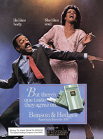


No, It’s Not Your Fault You’re Addicted
The long history of manipulation and deceit in tobacco advertising has left millions of people with lifelong nicotine addictions and, tragically, serious health conditions like lung cancer. Big Tobacco’s deliberate efforts to start and keep people smoking—including young people, teens, and even children—despite knowing the deadly consequences, has resulted in a public health crisis that continues to affect millions today.
Contact a Tobacco Litigation Lawyer Today
If you or a loved one has developed lung cancer as a result of a smoking addiction, you may be entitled to financial compensation. Read more about some of the most frequently asked questions about tobacco litigation in Massachusetts and whether it’s possible to get financial compensation for your lung cancer caused by smoking. If you’d like to know whether you might have a legitimate claim, reach out to our tobacco lawyers at Shepard O’Donnell for a free case evaluation. Please note that at this time, we are only taking cases in which the majority of the patient’s smoking history took place in Massachusetts.
Shepard O’Donnell does not own copyright in these images, and does not offer or license them for public or private use. As to copyright issues for tobacco advertisements, they have been reproduced with regularity in books, scholarly journals, popular magazines, and in numerous online venues for many years for purposes of comment, criticism, or parody, which may be considered transformative and thus considered fair use.
Should You Be Worried About Asbestos in Your Home?
Many people are now aware of the dangers of asbestos and how it has caused tens of thousands of workers on construction sites, in paper mills, in many trades (including plumbers, pipefitters, and mechanics), and even Navy veterans, to develop mesothelioma. Mesothelioma is caused when microscopic asbestos dust and fibers are breathed into the lungs, causing irritation and scarring that damages the lungs and pleura over time, taking up to 50 years after initial exposure to develop into a cancer and show symptoms.
Aside from workplace exposure, there is also potential for asbestos exposure in your own home. The danger is especially prevalent in older homes built before 1980. As home prices increase and it becomes harder for first-time home buyers to afford a newer house, buyers are increasingly turning to older “fixer-uppers,” intending to renovate. Unfortunately, many of these older homes were built before the widespread use of asbestos was stopped. In many cases, asbestos was used because of its durability, heat resistance, and fire resistance. If your home was built before 1980, it’s possible that some of its components contain asbestos and we caution you to do your research before beginning any renovation projects that involve:
- demolition
- sanding
- drilling
- grinding
- sawing
- hammering
- boiler or pipe removal
These activities will surely disturb any asbestos within your home and release potentially deadly dust and fibers into the air.
Don’t Renovate Until You Test For Asbestos
It doesn’t matter how much was used, if asbestos is present in any amount, it poses a danger. If you suspect the presence of asbestos, do not disturb it and seal off the area, if possible. The best way to know for sure if asbestos is present is to have a sample of the suspicious product tested.
Below we outline some of the most common places you might find asbestos in your older home. If you have plans to renovate any of these areas we urge you to take the necessary precautions and to contact a professional to help remove the asbestos and remediate the site.
Asbestos in The Ceiling
The dreaded “popcorn” ceiling and suspended ceilings are the worst offenders. Popcorn ceilings, popular from the 1950s to the 1980s, were often made with vermiculite, a material that regularly contained asbestos. This is the stuff that gives the ceiling its telltale rough and bumpy texture. Do not attempt to remove this material yourself!
Suspended ceilings, using individual tiles suspended within a frame, were often used in kitchens and basements to cover up unsightly ductwork and one of the most common materials used for these tiles was asbestos. Some estimates say that 5% to 10% of ceiling tiles in the US contain asbestos.
If you know the company that manufactured your tiles, you can check to see whether they did, in fact, use asbestos in their process, but this information is often not readily available. If you don’t have this information available, there are some clues to look for: most old asbestos ceiling tiles look light colored, slightly textured and powdery white, often with small dotted indentations. If you look on the back of the tile and it’s a salmon color, those particular tiles are also asbestos-containing.
Asbestos in The Floor
Vinyl floor tiles, sheet flooring, or linoleum sheet flooring were used extensively in homes constructed before the 1980s because of their durability, most often in kitchens, entryways, mudrooms, bathrooms, and finished basements. Many of today’s homeowners are opting for wood, tile, or luxury vinyl plank flooring. If you’re looking to change up your vinyl floors, be sure to find out if they contain asbestos before replacing them. In addition to their age, you can use the following clues to help identify hazardous material:
- Size: A bit thicker than modern vinyl tiles, the most common size for asbestos-containing vinyl floor tiles was 9″ x 9″, but they also came in 12″ x 12″ and 18″ x 18″.
- Color and pattern: Asbestos vinyl tiles were most often light blue, cream, pink, or green, while the most popular colors for asbestos vinyl sheet flooring were white, blue, and brown. They were often designed to look like carpeting, stone, or wood flooring.
- Stains: Many asbestos flooring was made with asphalt and over time, the oils from the asphalt leaks out, causing discoloration and fading.
- Adhesive backing: Thick black flooring adhesive underneath the tiles can also indicate the presence of asbestos. Linoleum and vinyl sheet flooring could also contain asbestos backing in the form of black tar paper or felt paper. Although the sheet itself doesn’t contain asbestos, the backing that serves as a cushion can contain high asbestos concentrations.
If you’re in the market to replace your older vinyl floors, be sure to have them tested before you start. Alternatively, you could choose to put a floor on top of them, leaving the old contaminated flooring in place, sealed off and undisturbed.
Asbestos in The Walls
After moving into your older home (and maybe after watching a few hours of HGTV) you may feel the urge to grab your sledgehammer and start the demo. STOP! You need to be mindful of the age of your home and whether you should be tearing down walls without a proper plan in place that protects you and your family from asbestos.
Drywall installed before 1980 might have used asbestos-containing joint compound to hide the seams and screws between the panels. Asbestos was often added to plaster – if your walls are labeled “fire-rated,” they definitely contain asbestos. Find out if your walls were produced by these common manufacturers of contaminated plaster walls. It is very important that you contain any dust created during the removal of these walls. We encourage you to hire a professional to determine if you can safely proceed!
Asbestos in The Basement
Many older homes have a boiler in the basement and it’s safe to say that any boiler installed before 1980 probably contains asbestos, especially if your boiler looks like a “snowman.” These cast iron snowman boilers—so called because they were short and round and covered with several inches of thick asbestos insulation—require special remediation companies to dispose of. The “jacketed” boiler, which is the type most people have, looks like a square or rectangle with a metal jacket on the outside and may not look like it has any asbestos in it, but, depending on the age of the boiler, the insulation behind that jacketing that could be asbestos. Any older boiler, whether snowman or jacketed, could also have asbestos insulation on the pipes: if you see a chalky white covering on your pipes, don’t touch it, don’t bang it, and make sure that, if it does turn out to be asbestos, it is handled properly before the rest of the boiler is replaced.
Asbestos in The Attic
If your old attic contains insulation made of cellulite or fiberglass, there is nothing for you to worry about. However, some old houses, especially those located close to vermiculite plants like those operated by WR Grace in Northampton in western Massachusetts, used a type of insulation made of vermiculite which, while not technically asbestos, is often contaminated with it. You can recognize this type of insulation by sight. Small, granular, and pebble-like material that resembles coarse sand, it is light and fluffy, and tan or light brown in color. It was typically blown into attics right on top of the ceiling in between the joists, and is especially vulnerable to being disturbed. Be sure to call a professional to remove this type of insulation.
Call Us For Help
If you or a loved one has worked on old houses in the past—whether as a DIY project or as your profession—and have developed mesothelioma, call us for a free consultation about whether you may be entitled to compensation. We take the time to explain the process from beginning to end, setting realistic expectations and timelines. If you are unable to come to our offices due to health or other reasons, we will come to you to listen to your story and tell you honestly if we think you have a viable claim. We have helped hundreds of individuals and families obtain justice for their injuries, regularly obtaining settlements and verdicts in the millions. And you will never pay unless we deliver results for you.
Thank-You to Our Veterans. And a special recognition to those who have developed mesothelioma as a result of their service.
Our deepest gratitude goes out to all military Veterans who so valiantly served our country, not just on this Veteran’s Day, but every day. Our men and women in uniform deserve the utmost respect for the sacrifices they make for the rest of us, which is why it’s so painful to learn that one of their gravest injuries was, by and large, preventable. We are referring to asbestos exposure, which has led to hundreds of mesothelioma diagnoses among our Veterans.
Our clients include veterans from all branches of the military, and we are honored when they share their stories—and sometimes their photos and mementos—with us. “While it is an honor to help these veterans and their families work through the process of litigating asbestos claims, it is also disheartening to know that because of their dedication and service, many veterans will continue to develop asbestos-related diseases every year,” says Partner Mike McCann, one of our experienced mesothelioma and lung cancer attorneys.
One-Third of All Mesothelioma Victims are Veterans
Shockingly, nearly one-third of all mesothelioma victims in the country are Veterans, most of whom served in the Navy at the time they were exposed. Veterans serving in the Army, Marine Corps, Air Force, Merchant Marines, and Army National Guard may also have been exposed to asbestos, leading to mesothelioma.
In fact, asbestos was so prevalent among Navy veterans that nearly every ship commissioned by the United States Navy between 1930 and 1970 contained several tons of asbestos insulation in the engine room, along the miles of pipe aboard ship, and in the walls and doors that required fireproofing.
Not only was asbestos found onboard the ships, it was also in the brakes and engines of Air Force and Naval aircrafts, land vehicles, and in many other products. These products had to be maintained and repaired on a regular basis and this work, often performed in cramped and dusty quarters, released asbestos fibers into the atmosphere, which could have been breathed in by anyone working in the nearby area. It was that dust that, decades later, has caused so many veterans to suffer from asbestos-related illnesses, including those who worked as:
- machinist mates
- firemen / boiler tenders
- electricians
- aviation technicians
- mechanics
- pilots and crew
- vehicle and heavy equipment mechanics
- land-based construction and maintenance teams
- seabees
- and others who worked in confined spaces
The use of products containing asbestos occurred on ships, in shipyards, in aircraft maintenance, motor pools, construction battalions, land and ship-based maintenance, heavy equipment, and almost anywhere that the Armed Forces were operating. Asbestos-containing products include:
- boilers
- pumps
- valves
- pipe and pipe systems
- turbine generators
- main propulsion turbines
- ship’s service generators
- deck coverings
- steam systems
- and much more
Read more about Veterans and asbestos exposure on our website and see below for a list of Navy ships on which asbestos exposure was prevalent.
Call an Experienced Mesothelioma Attorney Today
If you or a loved one is a Veteran who has developed mesothelioma as a result of asbestos exposure, call us for a free consultation about whether you may be entitled to compensation.
Note: We pursue compensation from the manufacturers of the asbestos-containing products that injured our veterans, not from the government or the military.
We will take the time to explain the process from beginning to end, setting realistic expectations and timelines. If you are unable to come to our offices due to health or other reasons, we will come to you to listen to your story and tell you honestly if we think you have a viable claim. We have helped hundreds of individuals and families obtain justice for their injuries, regularly obtaining settlements and verdicts in the millions. And you will never pay unless we deliver results for you.
- USS America | CVA 66
- USS Antietam | CV 36
- USS Bennington | CV 20 and CVS 20
- USS Bon Homme Richard | CV 31
- USS Boxer | CV 21
- USS Bunker Hill | CV 17
- USS Carl Vinson | CVN 70
- USS Constellation | CVA 64
- USS Coral Sea | CVA 43
- USS Dwight D. Eisenhower | CVN 69
- USS Enterprise | CVAN 65
- USS Essex | CV 9
- USS Forrestal | CVA 59
- USS Franklin | CV 13
- USS Franklin Roosevelt | CV 42
- USS Hancock | CV 19
- USS Hornet | CV 12 and CVS 12
- USS Independence | CVA 62
- USS Intrepid | CV 11
- USS John F. Kennedy | CVA 67
- USS Kearsarge | CV 33
- USS Kitty Hawk | CVA 63
- USS Lake Champlain | CV 39
- USS Langley | CV 1
- USS Lexington | CV 16
- USS Leyte | CV 32
- USS Midway | CV 41
- USS Nimitz | CVN 68
- USS Oriskany | CV 34
- USS Philippine Sea | CV 47
- USS Princeton | CV 37
- USS Randolph | CV 15
- USS Ranger | CVA 61
- USS Saipan | CVL 48
- USS Saratogo | CVA 60
- USS Shangri La | CV 38
- USS Tarawa | CV 40
- USS Ticonderoga | CV 14
- USS Valley Forge | CV 45
- USS Wasp | CV 18
- USS Wright | AVT 6
- USS Yorktown | CV 10
- USS Lexington | CV 2
- USS Saratoga | CV 3
- USS Wright | CVL 49
- USS Alabama | BB 60
- USS Arizona | BB 39
- USS Colorado | BB 45
- USS Idaho | BB 42
- USS Indiana | BB 58
- USS Iowa | BB 61
- USS Maryland | BB 46
- USS Massachusetts | BB 59
- USS Mississippi | BB 23
- USS Missouri | BB 63
- USS Nevada | BB 36
- USS New Jersey | BB 62
- USS New Mexico | BB 40
- USS North Carolina | BB 55
- USS Oklahoma | BB 37
- USS Pennsylvania | BB 38
- USS South Dakota | BB 57
- USS Tennessee | BB 44
- USS Washington | BB 56
- USS West Virginia | BB 48
- USS Wisconsin | BB 9
- USS Alaska | CB 1
- USS Albany | CG 10
- USS Amsterdam | CL 101
- USS Arkansas | CGN 41
- USS Astoria | CA 34
- USS Atlanta | CL 104
- USS Bainbridge | CGN 25
- USS Baltimore | CA 68
- USS Belknap | CG 26
- USS Biddle | CG 34
- USS Biloxi | CL 80
- USS Birmingham | CL 62
- USS Boise | CL 47
- USS Boston | CA 69
- USS Bremerton | CA 130
- USS Brooklyn | CL 40
- USS California | CGN 36
- USS Canberra | CA 70
- USS Chicago | CA 136, CG 11
- USS Cleveland | CL 55
- USS Columbia | CL 56
- USS Columbus | CA 74
- USS Dale | CG 19
- USS Dayton | CL 105
- USS Denver | CL 58
- USS Des Moines | CA 134
- USS Duluth | CL 87
- USS England | CG 22
- USS Fall River | CA 131
- USS Fargo | CL 106
- USS Flint | CL 64
- USS Fox | CG 33
- USS Fresno | CL/CLAA
- USS Galveston | CL 93
- USS Gridley | CG 21
- USS Guam | CB 2
- USS Halsey | CG 23
- USS Harry E. Yarnell | CG 17
- USS Hawaii | CB 3
- USS Helena | CL 50, CA 75
- USS Honolulu | CL 48
- USS Horne | CG 30
- USS Houston | CL 81
- USS Huntington | CL 107
- USS Indianapolis | CA 35
- USS Josephus Daniels | CG 27
- USS Jouett | CG 29
- USS Juneau | CL/CLAA
- USS Leahy | CG 16
- USS Little Rock | CL 92, CG 4, CGL 4
- USS Long Beach | CGN 9
- USS Los Angeles | CA 135
- USS Macon | CA 132
- USS Manchester | CL 83
- USS Miami | CL 89
- USS Minneapolis | CA 36
- USS Mississippi | CGN 40
- USS Mobile | CL 63
- USS Montpelier | CL 57
- USS Nashville | CL 43
- USS New Orleans | CL/CA 32
- USS Newport News | CA 148
- USS Northampton | CLC 1
- USS Oakland | CL/CLAA 95
- USS Oklahoma City | CL 91, CG
- USS Oregon City | CA 122
- USS Pasadena | CL 65
- USS Philadelphia | CL 41
- USS Phoenix | CL 46
- USS Pittsburgh | CA 72
- USS Portland | CA 33
- USS Portsmouth | CL 102
- USS Providence | CL 82
- USS Quincy | CA 39, CA 71
- USS Reeves | CG 24
- USS Reno | CL/CLAA 96
- USS Richmond K. Turner | CG 20
- USS Roanoke | CL 145
- USS Rochester | CA 124
- USS Salem | CA 139
- USS San Diego | CL 53
- USS San Francisco | CA 38
- USS San Juan | CL 54
- USS Santa Fe | CL 60
- USS Savannah | CL 42
- USS South Carolina | CGN 37
- USS Spokane | CL/CLAA 120
- USS Springfield | CL 66, CLG 7
- USS St. Louis | CL 49
- USS St. Paul | CA 73
- USS Sterett | CG 31
- USS Texas | CGN 39
- USS Ticonderoga | CG 47
- USS Toledo | CA 133
- USS Topeka | CL 67, CLG 8
- USS Truxtun | CGN 35
- USS Tuscaloosa | CA 37
- USS Tucson | CL/CLAA 98
- USS Vicksburg | CL 86, CG 69
- USS Vincennes | CA 44, CG 49
- USS Virginia | CGN 38
- USS Wainwright | CG 28
- USS Wichita | CA 45
- USS Wilkes Barre | CL 103
- USS William H. Standley | CG 32
- USS Worcester | CL 144
- USS Worden | CG 18
- USS Aaron Ward | DD 483
- USS Abbot | DD 629
- USS Agerholm | DD 826
- USS Albert W. Grant | DD 649
- USS Alfred A. Cunningham | DD 752
- USS Allen M. Sumner | DD 692
- USS Ammen | DD 527
- USS Anthony | DD 515
- USS Arnold J. Isbell | DD 869
- USS Arthur W. Radford | DD 968
- USS Aulick | DD 569
- USS Ault | DD 698
- USS Bache | DD 470
- USS Barry | DD 933
- USS Barton | DD 599
- USS Bausell | DD 845
- USS Beale | DD 471
- USS Bearss | DD 654
- USS Beatty | DD 640
- USS Bell | DD 587
- USS Benham | DD 796
- USS Bennett | DD 473
- USS Bennion | DD 662
- USS Bigelow | DD 942
- USS Black | DD 666
- USS Blandy | DD 943
- USS Blue | DD 744
- USS Borie | DD 704
- USS Boyd | DD 544
- USS Bradford | DD 545
- USS Braine | DD 630
- USS Brinkley Bass | DD 887
- USS Briscoe | DD 977
- USS Bristol | DD 614
- USS Brown | DD 546
- USS Brownson | DD 868
- USS Brush | DD 745
- USS Bryant | DD 665
- USS Buck | DD 761
- USS Bullard | DD 660
- USS Burns | DD 588
- USS Caperton | DD 650
- USS Capps | DD 550
- USS Caron | DD 970
- USS Cassin Young | DD 793
- USS Castle | DD 720
- USS Charrette | DD 581
- USS Charles Ausburne | DD 570
- USS Charles H. Roan | DD 853
- USS Charles J. Badger | DD 657
- USS Charles R. Ware | DD 865
- USS Charles S. Sperry | DD 697
- USS Chauncey | DD 667
- USS Clarence K. Bronson | DD 668
- USS Claxton | DD 571
- USS Cogswell | DD 651
- USS Colahan | DD 658
- USS Collett | DD 730
- USS Compton | DD 705
- USS Comte De Grasse | DD 974
- USS Cone | DD 866
- USS Conner | DD 582
- USS Conolly | DD 979
- USS Converse | DD 509
- USS Conway | DD 507
- USS Cony | DD 508
- USS Corry | DD 817
- USS Cotten | DD 669
- USS Cowell | D 547
- USS Cushing | DD 797
- USS Cushing | DD 985
- USS Daley | DD 519
- USS Dashiell | DD 659
- USS David R. Ray | DD 971
- USS Davis | DD 937
- USS Davis W. Taylor | DD 551
- USS De Haven | DD 727
- USS Deyo | DD 989
- USS Dortch | DD 670
- USS Douglas H. Fox | DD 779
- USS Du Pont | DD 941
- USS Dyson | DD 572
- USS Eaton | DD 510
- USS Edson | DD 946
- USS Elliott | DD 967
- USS English | DD 696
- USS Erben | DD 631
- USS Ernest G. Small | DD 838
- USS Eugene A. Greene | DD 711
- USS Eversole | DD 789
- USS Fechteler | DD 870
- USS Fife | DD 991
- USS Fiske | DD 842
- USS Fletcher | DD 445
- USS Fletcher | DD 992
- USS Floyd B. Parks | DD 884
- USS Foote | DD 511
- USS Forest Royal | DD 872
- USS Forrest Sherman | DD 931
- USS Frank E. Evans | DD 754
- USS Franks | DD 554
- USS Fullam | DD 474
- USS Gainard | DD 706
- USS Gatling | DD 671
- USS Gearing | DD 710
- USS George K. Mackenzie | DD 836
- USS Glennon | DD 840
- USS Gregory | DD 802
- USS Guest | DD 472
- USS Gurke | DD 783
- USS Gyatt | DD 712
- USS Hailey | DD 556
- USS Hale | DD 642
- USS Halford | DD 480
- USS Hall | DD 583
- USS Halsey Powell | DD 686
- USS Hamner | DD 718
- USS Hank | DD 702
- USS Haraden | DD 585
- USS Harlan R. Dickson | DD 708
- USS Harold J. Ellison | DD 864
- USS Harrison | DD 573
- USS Harry E. Hubbard | DD 748
- USS Harry W. Hill | DD 986
- USS Hart | DD 594
- USS Haynsworth | DD 700
- USS Hazelwood | DD 531
- USS Healy | DD 672
- USS Heerman | DD 532
- USS Henderson | DD 785
- USS Henley | DD 391
- USS Hewitt | DD 966
- USS Heywood L. Edwards | DD 663
- USS Hickox | DD 673
- USS Hollister | DD 788
- USS Hopewell | DD 681
- USS Howorth | DD 592
- USS Hugh W. Hadley | DD 774
- USS Hudson | DD 475
- USS Hugh Purvis | DD 709
- USS Hull | DD 945
- USS Hunt | DD 674
- USS Hyman | DD 732
- USS Ingersoll | DD 652
- USS Ingersoll | DD 990
- USS Ingraham | DD 694
- USS Irwin | DD 794
- USS Isherwood | DD 520
- USS Izard | DD 589
- USS J. William Ditter | DD 751
- USS James C. Owens | DD 776
- USS James E. Kyes | DD 787
- USS Jarvis | DD 799
- USS Jenkins | DD 447
- USS Joh Rodgers | DD 983
- USS Joh Young | DD 973
- USS John A. Bole | DD 755
- USS John D. Henley | DD 553
- USS John Hancock | DD 981
- USS John Hood | DD 655
- USS John R. Craig | DD 885
- USS John R. Pierce | DD 753
- USS John Rodgers | DD 574
- USS John W. Thomason | DD 760
- USS John W. Weeks | DD 701
- USS Johnston | DD 821
- USS Jonas Ingram | DD 938
- USS Joseph P. Kennedy Jr. | DD 850
- USS Kenneth D. Bailey | DD 713
- USS Kidd | DD 661
- USS Killen | DD 593
- USS Kimberly | DD 521
- USS Kinkaid | DD 965
- USS Knapp | DD 653
- USS La Vallette | DD 448
- USS Laffey | DD 724
- USS Lansdale | DD 766
- USS Laws | DD 558
- USS Leftwich | DD 984
- USS Leonard F. Mason | DD 852
- USS Lewis Hancock | DD 675
- USS Lofberg | DD 759
- USS Lowry | DD 770
- USS Lyman K. Swenson | DD 729
- USS Maddox | DD 731
- USS Manley | DD 940
- USS Mansfield | DD 728
- USS Marshall | DD 676
- USS Massey | DD 778
- USS McCord | DD 534
- USS McDermut | DD 677
- USS McGowen | DD 678
- USS McKean | DD 784
- USS McKee | DD 575
- USS McNair | DD 679
- USS Melvin | DD 680
- USS Meredith | DD 890
- USS Merrill | DD 976
- USS Mertz | DD 691
- USS Metcalf | DD 595
- USS Miller | DD 535
- USS Moale | DD 693
- USS Monssen | DD 798
- USS Moosbrugger | DD 980
- USS Morton | DD 948
- USS Mullany | DD 528
- USS Mullinnix | DD 944
- USS Murray | DD 576
- USS Nelson | DD 623
- USS Nicholas | DD 449
- USS Nicholson | DD 982
- USS Noa | DD 841
- USS Norman Scott | DD 690
- USS O’Bannon | DD 450
- USS O’Bannon | DD 987
- USS O’Brien | DD 725
- USS O’Brien | DD 975
- USS O’Hare | DD 889
- USS Oldendorf | DD 972
- USS Orleck | DD 886
- USS Owen | DD 536
- USS Ozbourn | DD 846
- USS Paul F. Foster | DD 964
- USS Paul Hamilton | DD 590
- USS Perry | DD 844
- USS Peterson | DD 969
- USS Philip | DD 498
- USS Picking | DD 685
- USS Porter | DD 800
- USS Porterfield | DD 682
- USS Power | DD 839
- USS Preston | DD 795
- USS Pritchett | DD 561
- USS Purdy | DD 734
- USS Putnam | DD 757
- USS Radford | DD 446
- USS Remey | DD 688
- USS Renshaw | DD 499
- USS Richard B. Anderson | DD 786
- USS Richard P. Leary | DD 664
- USS Richard S. Edwards | DD 950
- USS Ringgold | DD 500
- USS Robert H. McCard | DD 822
- USS Robert K. Huntington | DD 781
- USS Robinson | DD 562
- USS Rooks | DD 804
- USS Ross | DD 563
- USS Rowan | DD 782
- USS Rowe | DD 564
- USS Rupertus | DD 851
- USS Samuel B. Roberts | DD 823
- USS Samuel l. Moore | DD 747
- USS Sarsfield | DD 837
- USS Saufley | DD 465
- USS Schroeder | DD 501
- USS Seaman | DD 791
- USS Seymour D. Owens | DD 767
- USS Shelton | DD 790
- USS Shields | DD 596
- USS Sigourney | DD 643
- USS Sigsbee | DD 502
- USS Smalley | DD 565
- USS Soley | DD 707
- USS Sproston | DD 577
- USS Spruance | DD 963
- USS Stanley | DD 478
- USS Steinaker | DD 863
- USS Stembel | DD 644
- USS Stephen Potter | DD 538
- USS Stevens | DD 479
- USS Stickell | DD 888
- USS Stockham | DD 683
- USS Stoddard | DD 566
- USS Stormes | DD 780
- USS Stribling | DD 867
- USS Strong | DD 758
- USS Stump | DD 978
- USS Taussig | DD 746
- USS Taylor | DD 468
- USS Terry | DD 513
- USS The Sullivans | DD 537
- USS Theodore E. Chandler | DD 717
- USS Thorn | DD 988
- USS Tingey | DD 539
- USS Trathen | DD 530
- USS Turner Joy | DD 951
- USS Twining | DD 540
- USS Uhlmann | DD 687
- USS Van Valkenburgh | DD 656
- USS Vogelgesang | DD 862
- USS Wadleigh | DD 689
- USS Wadsworth | DD 516
- USS Waldron | DD 699
- USS Walke | DD 723
- USS Walker | DD 517
- USS Wallace L. Lind | DD 703
- USS Waller | DD 466
- USS Warrington | DD 843
- USS Watts | DD 567
- USS Wedderburn | DD 684
- USS Wickes | DD 578
- USS Wiley | DD 597
- USS Willard Keith | DD 775
- USS William C. Lawe | DD 763
- USS William M. Wood | DD 715
- USS William R. Rush | DD 714
- USS Wiltsie | DD 716
- USS Witek | DD 848
- USS Woodrow R. Thompson | DD 721
- USS Wren | DD 568
- USS Yarnall | DD 541
- USS Young | DD 580
- USS Zellars | DD 777
- USS Abercrombie | DE 343
- USS Acree | DE 167
- USS Ahrens | DE 575
- USS Albert T. Harris | DE 447
- USS Alexander J. Luke | DE 577
- USS Allentown | DE 52
- USS Alvin C. Cockrell | DE 366
- USS Amick | DE 168
- USS Andres | DE 45
- USS Atherton | DE 169
- USS Austin | DE 15
- USS Baker | DE 190
- USS Bangust | DE 739
- USS Baron | DE 166
- USS Bath | DE 55
- USS Bauer | DE 1025
- USS Bebas | DE 10
- USS Bivin | DE 536
- USS Blair | DE 147
- USS Booth | DE 170
- USS Bostick | DE 1025
- USS Brackett | DE 41
- USS Breeman | DE 104
- USS Brennan | DE 13
- USS Bridget | DE 1024
- USS Bright | DE 747
- USS Brister | DE 327
- USS Bronstein | DE 1037
- USS Bronstein | DE 189
- USS Brough | DE 148
- USS Buckley | DE 51
- USS Burden R. Hastings | DE 19
- USS Burrows | DE 105
- USS Cabana | DE 260
- USS Calcaterra | DE 390
- USS Camp | DE 251
- USS Canfield | DE 262
- USS Carlson | DE 9
- USS Carroll | DE 171
- USS Carter | DE 112
- USS Cates | DE 763
- USS Cecil J. Doyle | DE 368
- USS Chambers | DE 391
- USS Charles Berry | DE 1035
- USS Charles E. Brannon | DE 446
- USS Charles J. Kimmel | DE 584
- USS Charles Lawrence | DE 53
- USS Charles R. Greer | DE 231
- USS Charlottesville | DE 35
- USS Chatelain | DE 149
- USS Chester T. O’Brien | DE 421
- USS Clarence L. Evans | DE 113
- USS Claud Jones | DE 1033
- USS Cloues | DE 265
- USS Coates | DE 685
- USS Cockrill | DE 398
- USS Coffman | DE 191
- USS Conklin | DE 439
- USS Connolly | DE 306
- USS Coolbaugh | DE 217
- USS Cooner | DE 172
- USS Corbesier | DE 438
- USS Courtney | DE 1021
- USS Cromwell | DE 1014
- USS Cronin | DE 704
- USS Cross | DE 448
- USS Crouter | DE 11
- USS Crowley | DE 303
- USS Currier | DE 700
- USS Dale W. Peterson | DE 337
- USS Damon M. Cummings | DE 643
- USS Daniel | DE 335
- USS Daniel A. Joy | DE 585
- USS Darby | DE 218
- USS Day | DE 225
- USS De Long | DE 684
- USS Dealey | DE 1006
- USS Dearborn | DE 33
- USS Decker | DE 47
- USS Deede | DE 263
- USS Dempsey | DE 26
- USS Dennis | DE 405
- USS Dianne | DE 261
- USS Dobler | DE 48
- USS Doherty | DE 14
- USS Donaldson | DE 44
- USS Doneff | DE 49
- USS Douglas A. Munro | DE 422
- USS Douglas l. Howard | DE 138
- USS Doyle C. Barnes | DE 353
- USS Duffy | DE 27
- USS Dufilho | DE 423
- USS Durant | DE 389
- USS Earl K. Olsen | DE 765
- USS Earl V. Johnson | DE 702
- USS Ebert | DE 768
- USS Edgar G. Chase | DE 16
- USS Edmonds | DE 406
- USS Edsall | DE 129
- USS Edward C. Daly | DE 17
- USS Edwin A. Howard | DE 346
- USS Edward H. Allen | DE 531
- USS Eichenberger | DE 202
- USS Eisele | DE 34
- USS Eisner | DE 192
- USS Elden | DE 264
- USS Eldridge | DE 173
- USS Emery | DE 28
- USS Emporia | DE 28
- USS Engstrom | DE 50
- USS Eugene E. Elmore | DE 686
- USS Evans | DE 1023
- USS Evarts | DE 5
- USS Fair | DE 35
- USS Falgout | DE 324
- USS Fessenden | DE 142
- USS Fieberling | DE 640
- USS Finch | DE 328
- USS Finnegan | DE 307
- USS Flaherty | DE 135
- USS Fleming | DE 32
- USS Fogg | DE 577
- USS Forman | DE 633
- USS Formoe | DE 509
- USS Forster | DE 334
- USS Foss | DE 59
- USS Fowler | DE 222
- USS Francis M. Robinson | DE 220
- USS Farquhar | DE 139
- USS French | DE 367
- USS Frost | DE 144
- USS Frybarger | DE 705
- USS Gandy | DE 764
- USS Garfield Thomas | DE 193
- USS Gendreau | DE 639
- USS Gentry | DE 349
- USS George | DE 697
- USS George A. Johnson | DE 583
- USS George E. Davis | DE 357
- USS Gillette | DE 681
- USS Gilligan | DE 508
- USS Gilmore | DE 189
- USS Gloucester | DE 22
- USS Goss | DE 444
- USS Grady | DE 445
- USS Grand Rapids | DE 31
- USS Greenwood | DE 679
- USS Greiner | DE 37
- USS Griswold | DE 7
- USS Groton | DE 29
- USS Gunason | DE 795
- USS Gustafson | DE 182
- USS Haas | DE 424
- USS Halloran | DE 305
- USS Hamman | DE 131
- USS Hammerberg | DE 1015
- USS Hanna | DE 449
- USS Harmon | DE 678
- USS Harold C. Thomas | DE 21
- USS Hartley | DE 1029
- USS Harveson | DE 316
- USS Haverfield | DE 393
- USS Hebert C. Jones | DE 137
- USS Hemminger | DE 746
- USS Henry R. Kenyon | DE 683
- USS Heyliger | DE 510
- USS Hilbert | DE 742
- USS Hill | DE 141
- USS Hingham | DE 30
- USS Hissem | DE 400
- USS Hodges | DE 231
- USS Holt | DE 706
- USS Holton | DE 703
- USS Hooper | DE 1026
- USS Howard D. Crow | DE 252
- USS Howard F. Clark | DE 533
- USS Hurst | DE 250
- USS Huse | DE 145
- USS Inch | DE 146
- USS J. Douglas Blackwood | DE 219
- USS J. Richard Ward | DE 243
- USS J.R.Y. Blakely | DE 140
- USS Jaccard | DE 355
- USS Jack Miller | DE 410
- USS Jack W. Wilke | DE 800
- USS Jacob Jones | DE 130
- USS James E. Craig | DE 201
- USS Janssen | DE 396
- USS Jesse Rutherford | DE 347
- USS Jobb | DE 707
- USS John C. Butler | DE 339
- USS John J. Powers | DE 528
- USS John L. Williamson | DE 370
- USS John M. Bermingham | DE 530
- USS John R. Perry | DE 1034
- USS John Willis | DE 1027
- USS Johnnie Hutchins | DE 360
- USS Jordan | DE 204
- USS Joseph E. Connolly | DE 450
- USS Joseph K. Taussig | DE 1030
- USS Joyce | DE 317
- USS Keith | DE 241
- USS Kendal C. Campbell | DE 443
- USS Kenneth M. Willett | DE 354
- USS Key | DE 348
- USS Kirkpatrick | DE 318
- USS Koiner | DE 331
- USS Kretchmer | DE 329
- USS Kyne | DE 744
- USS La Prade | DE 409
- USS Lake | DE 301
- USS Lamons | DE 743
- USS Lansing | DE 388
- USS Lawrence C. Taylor | DE 415
- USS Le Hardy | DE 20
- USS Le Ray Wilson | DE 414
- USS Leland E. Thomas | DE 420
- USS Leslie L. B. Knox | DE 580
- USS Lester | DE 1022
- USS Levy | DE 162
- USS Lewis | DE 535
- USS Lloyd E. Acree | DE 356
- USS Loeser | DE 680
- USS Lough | DE 586
- USS Lovelace | DE 198
- USS Lovering | DE 39
- USS Lowe | DE 325
- USS Lyman | DE 302
- USS Mack | DE 358
- USS Major | DE 796
- USS Manlove | DE 36
- USS Manning | DE 199
- USS Marchand | DE 249
- USS Marsh | DE 699
- USS Martin | DE 30
- USS Martin H. Ray | DE 338
- USS Mason | DE 529
- USS Maurice J. Manuel | DE 351
- USS McClelland | DE 750
- USS McCloy | DE 1038
- USS McConnell | DE 163
- USS McCoy Reynolds | DE 440
- USS McGinty | DE 365
- USS McMorris | DE 1036
- USS McNulty | DE 581
- USS Melvin R. Nawman | DE 416
- USS Menges | DE 320
- USS Merrill | DE 392
- USS Metivier | DE 582
- USS Micka | DE 176
- USS Mills | DE 383
- USS Mitchell | De 43
- USS Moore | DE 240
- USS Mosley | DE 321
- USS Muir | DE 770
- USS Muskegon | DE 24
- USS Naifeh | DE 352
- USS Neal A. Scott | DE 769
- USS Neuendorf | DE 200
- USS Neunzer | DE 150
- USS Newell | DE 322
- USS Newport | DE 27
- USS O’Flaherty | DE 340
- USS Oliver Mitchel | DE 417
- USS O’Neill | DE 188
- USS O’Reilly | DE 330
- USS Osberg | DE 538
- USS Osmus | DE 701
- USS Osterhaus | DE 164
- USS Oswald | DE 767
- USS O’Toole | DE 527
- USS Otter | DE 210
- USS Otterstetter | DE 244
- USS Parks | DE 165
- USS Parle | DE 708
- USS Paul G. Baker | DE 642
- USS Peiffer | DE 588
- USS Peterson | DE 152
- USS Pettit | DE 253
- USS Pillsbury | DE 133
- USS Poole | DE 151
- USS Pope | DE 134
- USS Poughkeepsie | DE 26
- USS Pratt | DE 363
- USS Presley | DE 371
- USS Price | DE 332
- USS Pride | DE 323
- USS Raby | DE 698
- USS Rall | DE 304
- USS Ramsden | DE 382
- USS Raymond | DE 341
- USS Reuben James | DE 152
- USS Reynolds | DE 42
- USS Rhodes | DE 384
- USS Richard M. Rowell | DE 403
- USS Richard S. Bull | DE 402
- USS Richard W. Suesens | DE 342
- USS Richey | DE 385
- USS Ricketts | DE 254
- USS Riddle | DE 185
- USS Riley | DE 579
- USS Rinehart | DE 196
- USS Rizzi | DE 537
- USS Robert Brazier | DE 345
- USS Robert E. Peary | DE 132
- USS Robert F. Keller | DE 419
- USS Robert I. Paine | DE 578
- USS Roberts | DE 749
- USS Roche | DE 197
- USS Rolf | DE 362
- USS Rombach | DE 364
- USS Roy O. Hale | DE 336
- USS Rudderow | DE 224
- USS Samuel S. Miles | DE 183
- USS Sanders | DE 40
- USS Sandusky | DE 54
- USS Savage | DE 386
- USS Scroggins | DE 799
- USS Sederstrom | DE 31
- USS Seid | DE 256
- USS Sellstrom | DE 255
- USS Shreveport | DE 23
- USS Silverstein | DE 534
- USS Slater | DE 766
- USS Sloat | DE 245
- USS Smartt | DE 257
- USS Snowden | DE 246
- USS Snyder | DE 745
- USS Solar | DE 221
- USS Spangenberg | DE 223
- USS Spangler | DE 696
- USS Stadtfeld | DE 29
- USS Stafford | DE 411
- USS Stanton | DE 247
- USS Steele | DE 8
- USS Stern | DE 187
- USS Stewart | DE 238
- USS Stockdale | DE 399
- USS Straub | DE 181
- USS Straus | DE 408
- USS Strickland | DE 333
- USS Sturtevant | DE 239
- USS Sutton | DE 771
- USS Swasey | DE 248
- USS Swearer | DE 186
- USS Swenning | DE 394
- USS Tabberer | DE 418
- USS Thaddeus parker | DE 369
- USS Thomas | DE 102
- USS Thomas F. Nickel | DE 587
- USS Thomas J. Gary | DE 326
- USS Thomasson | DE 203
- USS Thornhill | DE 195
- USS Tills | DE 748
- USS Tinsman | DE 589
- USS Tisdale | DE 33
- USS Tomich | DE 242
- USS Traw | DE 350
- USS Trumpeter | DE 180
- USS Tweedy | DE 532
- USS Ulvert M. Moore | DE 442
- USS Vammen | DE 644
- USS Van Voorhis | DE 1028
- USS Vance | DE 387
- USS Vandivier | DE 540
- USS Varian | DE 798
- USS Wagner | DE 539
- USS Walter C. Wann | DE 412
- USS Walter S. Brown | DE 258
- USS Walton | DE 361
- USS Waterman | DE 740
- USS Weaver | DE 741
- USS Weeden | DE 797
- USS Wesson | DE 184
- USS Whitehurst | DE 634
- USS Whitman | DE 24
- USS Wileman | DE 22
- USS Wilhoite | DE 397
- USS William C. Cole | DE 641
- USS William C. Miller | DE 259
- USS William Seiverling | DE 441
- USS William T. Powel | DE 213
- USS Williams | DE 372
- USS Willis | DE 395
- USS Willmarth | DE 638
- USS Wingfield | DE 194
- USS Wintle | DE 25
- USS Wiseman | DE 667
- USS Woodson | DE 359
- USS Woonsocket | DE 32
- USS Wyffels | DE 6
- USS Wyman | DE 38
- USS Adams | DM 27
- USS Gwin | DM 33
- USS Harry F. Bauer | DM 26
- USS Henry A. Wiley | DM 29
- USS Lindsey | DM 32
- USS Robert H. Smith | DM 23
- USS Shannon | DM 25
- USS Shea | DM 30
- USS Thomas E. Fraser | DM 24
- USS Tolman | DM 28
- USS Puget Sound | AD 38
- USS Samuel Gompers | AD 37
- USS Altamaha | CVE 18
- USS Anzio | CVE 57
- USS Badoeng Strait | CVE 116
- USS Bairoko | CVE 115
- USS Barnes | CVE 20
- USS Bataan | CVL 29
- USS Belleau Wood | CVL 24
- USS Block Island | CVE 106
- USS Bogue | CVE 9
- USS Bougainville | CVE 100
- USS Breton | CVE 23
- USS Cabot | CVL 27
- USS Cape Esperance | CVE 88
- USS Cape Gloucester | CVE 109
- USS Card | CVE 11
- USS Charger | CVE 30
- USS Chenango | CVE 26
- USS Commencement Bay | CVE 105
- USS Copahee | CVE 12
- USS Core | CVE 13
- USS Corregidor | CVE 58
- USS Cowpens | CVL 25
- USS Croatan | CVE 25
- USS Fanshaw Bay | CVE 70
- USS Gilbert Islands | CVE 107
- USS Guadacanal | CVE 60
- USS Hoggatt Bay | CVE 75
- USS Hollandia | CVE 97
- USS Independence | CVL 22
- USS Kadashan bay | CVE 76
- USS Kasaan Bay | CVE 69
- USS Kula Gulf | CVE 108
- USS Kwajalein | CVE 98
- USS Langley | CVL 28
- USS Long Island | CVE 1
- USS Lunga Point | CVE 94
- USS Makassar Strait | CVE 91
- USS Manila Bay | CVE 61
- USS Marcus Island | CVE 77
- USS Matanikau | CVE 101
- USS Mindoro | CVE 120
- USS Mission Bay | CVE 59
- USS Monterey | CVL 26
- USS Munda | CVE 104
- USS Nassau | CVE 16
- USS Natoma Bay | CVE 62
- USS Nehenta Bay | CVE 74
- USS Palau | CVE 122
- USS Petrof Bay | CVE 80
- USS Point Cruz | CVE 119
- USS Prince William | CVE 31
- USS Puget Sound | CVE 113
- USS Rabaul | CVE 121
- USS Rendova | CVE 114
- USS Rudyerd Bay | CVE 81
- USS Saginaw Bay | CVE 82
- USS Saidor | CVE 117
- USS Salerno Bay | CVE 110
- USS San Jacinto | CVL 30
- USS Sangamon | CVE 27
- USS Santee | CVE 28
- USS Sargent Bay | CVE 83
- USS Savo Island | CVE 78
- USS Shamrock Bay | CVE 84
- USS Shipley Bay | CVE 85
- USS Siboney | CVE 112
- USS Sicily | CVE 118
- USS Sitkoh Bay | CVE 86
- USS Streamer Bay | CVE 87
- USS Suwanee | CVE 29
- USS Takanis Bay | CVE 89
- USS Thetis Bay | CVE 90
- USS Tinian | CVE 123
- USS Tripoli | CVE 64
- USS Vella Gulf | CVE 111
- USS White Plains | CVE 66
- USS Windham Bay | CVE 92
- USS Basilone | DDE 824
- USS Carpenter | DDE 825
- USS Damato | DDE 871, DD 871
- USS Epperson | DDE 719
- USS Fred T. Berry | DDE 858
- USS Harwood | DDE 861
- USS Holder | DDE 819
- USS Keppler | DDE 765
- USS LLoyd Thomas | DDE 764
- USS McCaffery | DDE 860
- USS New | DDE 818
- USS Norris | DDE 859
- USS Rich | DDE 820
- USS Robert A. Owens | DDE 827
- USS Robert l. Wilson | DDE 847
- USS Sarsfield | DDE 837
- USS America | CVA 66
- USS Antietam | CV 36
- USS Bennington | CV 20 and CVS 20
- USS Bon Homme Richard | CV 31
- USS Boxer | CV 21
- USS Bunker Hill | CV 17
- USS Carl Vinson | CVN 70
- USS Constellation | CVA 64
- USS Coral Sea | CVA 43
- USS Dwight D. Eisenhower | CVN 69
- USS Enterprise | CVAN 65
- USS Essex | CV 9
- USS Forrestal | CVA 59
- USS Franklin | CV 13
- USS Franklin Roosevelt | CV 42
- USS Hancock | CV 19
- USS Hornet | CV 12 and CVS 12
- USS Independence | CVA 62
- USS Intrepid | CV 11
- USS John F. Kennedy | CVA 67
- USS Kearsarge | CV 33
- USS Kitty Hawk | CVA 63
- USS Lake Champlain | CV 39
- USS Langley | CV 1
- USS Lexington | CV 16
- USS Leyte | CV 32
- USS Midway | CV 41
- USS Nimitz | CVN 68
- USS Oriskany | CV 34
- USS Philippine Sea | CV 47
- USS Princeton | CV 37
- USS Randolph | CV 15
- USS Ranger | CVA 61
- USS Saipan | CVL 48
- USS Saratogo | CVA 60
- USS Shangri La | CV 38
- USS Tarawa | CV 40
- USS Ticonderoga | CV 14
- USS Valley Forge | CV 45
- USS Wasp | CV 18
- USS Wright | AVT 6
- USS Yorktown | CV 10
- USS Lexington | CV 2
- USS Saratoga | CV 3
- USS Wright | CVL 49
- USS Alabama | BB 60
- USS Arizona | BB 39
- USS Colorado | BB 45
- USS Idaho | BB 42
- USS Indiana | BB 58
- USS Iowa | BB 61
- USS Maryland | BB 46
- USS Massachusetts | BB 59
- USS Mississippi | BB 23
- USS Missouri | BB 63
- USS Nevada | BB 36
- USS New Jersey | BB 62
- USS New Mexico | BB 40
- USS North Carolina | BB 55
- USS Oklahoma | BB 37
- USS Pennsylvania | BB 38
- USS South Dakota | BB 57
- USS Tennessee | BB 44
- USS Washington | BB 56
- USS West Virginia | BB 48
- USS Wisconsin | BB 9
- USS Alaska | CB 1
- USS Albany | CG 10
- USS Amsterdam | CL 101
- USS Arkansas | CGN 41
- USS Astoria | CA 34
- USS Atlanta | CL 104
- USS Bainbridge | CGN 25
- USS Baltimore | CA 68
- USS Belknap | CG 26
- USS Biddle | CG 34
- USS Biloxi | CL 80
- USS Birmingham | CL 62
- USS Boise | CL 47
- USS Boston | CA 69
- USS Bremerton | CA 130
- USS Brooklyn | CL 40
- USS California | CGN 36
- USS Canberra | CA 70
- USS Chicago | CA 136, CG 11
- USS Cleveland | CL 55
- USS Columbia | CL 56
- USS Columbus | CA 74
- USS Dale | CG 19
- USS Dayton | CL 105
- USS Denver | CL 58
- USS Des Moines | CA 134
- USS Duluth | CL 87
- USS England | CG 22
- USS Fall River | CA 131
- USS Fargo | CL 106
- USS Flint | CL 64
- USS Fox | CG 33
- USS Fresno | CL/CLAA
- USS Galveston | CL 93
- USS Gridley | CG 21
- USS Guam | CB 2
- USS Halsey | CG 23
- USS Harry E. Yarnell | CG 17
- USS Hawaii | CB 3
- USS Helena | CL 50, CA 75
- USS Honolulu | CL 48
- USS Horne | CG 30
- USS Houston | CL 81
- USS Huntington | CL 107
- USS Indianapolis | CA 35
- USS Josephus Daniels | CG 27
- USS Jouett | CG 29
- USS Juneau | CL/CLAA
- USS Leahy | CG 16
- USS Little Rock | CL 92, CG 4, CGL 4
- USS Long Beach | CGN 9
- USS Los Angeles | CA 135
- USS Macon | CA 132
- USS Manchester | CL 83
- USS Miami | CL 89
- USS Minneapolis | CA 36
- USS Mississippi | CGN 40
- USS Mobile | CL 63
- USS Montpelier | CL 57
- USS Nashville | CL 43
- USS New Orleans | CL/CA 32
- USS Newport News | CA 148
- USS Northampton | CLC 1
- USS Oakland | CL/CLAA 95
- USS Oklahoma City | CL 91, CG
- USS Oregon City | CA 122
- USS Pasadena | CL 65
- USS Philadelphia | CL 41
- USS Phoenix | CL 46
- USS Pittsburgh | CA 72
- USS Portland | CA 33
- USS Portsmouth | CL 102
- USS Providence | CL 82
- USS Quincy | CA 39, CA 71
- USS Reeves | CG 24
- USS Reno | CL/CLAA 96
- USS Richmond K. Turner | CG 20
- USS Roanoke | CL 145
- USS Rochester | CA 124
- USS Salem | CA 139
- USS San Diego | CL 53
- USS San Francisco | CA 38
- USS San Juan | CL 54
- USS Santa Fe | CL 60
- USS Savannah | CL 42
- USS South Carolina | CGN 37
- USS Spokane | CL/CLAA 120
- USS Springfield | CL 66, CLG 7
- USS St. Louis | CL 49
- USS St. Paul | CA 73
- USS Sterett | CG 31
- USS Texas | CGN 39
- USS Ticonderoga | CG 47
- USS Toledo | CA 133
- USS Topeka | CL 67, CLG 8
- USS Truxtun | CGN 35
- USS Tuscaloosa | CA 37
- USS Tucson | CL/CLAA 98
- USS Vicksburg | CL 86, CG 69
- USS Vincennes | CA 44, CG 49
- USS Virginia | CGN 38
- USS Wainwright | CG 28
- USS Wichita | CA 45
- USS Wilkes Barre | CL 103
- USS William H. Standley | CG 32
- USS Worcester | CL 144
- USS Worden | CG 18
- USS Van Valkenburgh | DD 656
- USS Vogelgesang | DD 862
- USS Wadleigh | DD 689
- USS Wadsworth | DD 516
- USS Waldron | DD 699
- USS Walke | DD 723
- USS Walker | DD 517
- USS Wallace L. Lind | DD 703
- USS Waller | DD 466
- USS Warrington | DD 843
- USS Watts | DD 567
- USS Wedderburn | DD 684
- USS Wickes | DD 578
- USS Wiley | DD 597
- USS Willard Keith | DD 775
- USS William C. Lawe | DD 763
- USS William M. Wood | DD 715
- USS William R. Rush | DD 714
- USS Wiltsie | DD 716
- USS Witek | DD 848
- USS Woodrow R. Thompson | DD 721
- USS Wren | DD 568
- USS Yarnall | DD 541
- USS Young | DD 580
- USS Zellars | DD 777
Shepard O’Donnell Named a Top-Tier Personal Injury Law Firm by Best Lawyers® “Best Law Firms” 2025
Shepard O’Donnell, one of the top asbestos personal injury law firms in Massachusetts for 26 years, received top-tier designation in the Best Lawyers® “Best Law Firms” 2025 edition. For the third year in a row, the firm was ranked “Tier 1” in personal injury litigation and was highly rated in mass tort litigation and class actions. Law firms included in the “Best Law Firms” rankings are recognized for professional excellence and consistently strong ratings from clients and peers. Below are the firm’s complete rankings.
Metropolitan Tier 1 (Boston)
- Personal Injury Litigation – Plaintiffs
Metropolitan Tier 3 (Boston)
- Mass Tort Litigation / Class Actions – Plaintiffs
The Best Lawyers “Best Law Firms” rankings are determined by an exhaustive evaluation process that includes the collection of client and lawyer evaluations, peer review from leading attorneys in their field and review of additional information provided by law firms as part of the formal submission process. To be eligible for a ranking in a particular practice area and metro region, a law firm must have at least one lawyer included in Best Lawyers in that particular practice area and metro.




